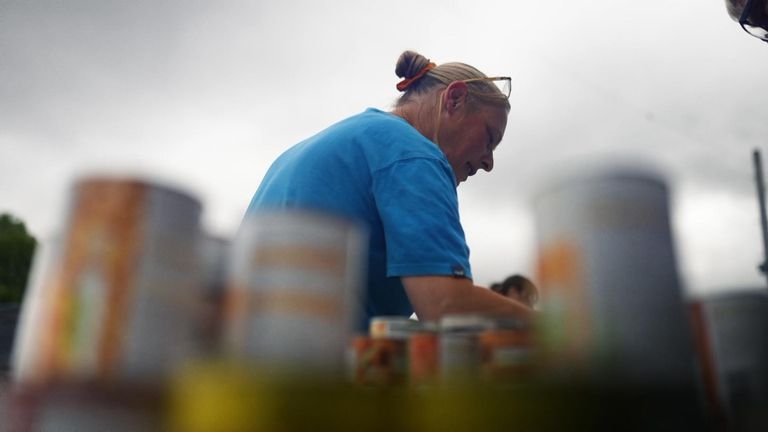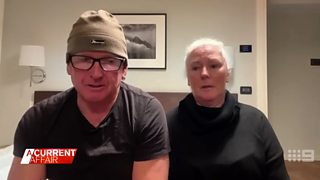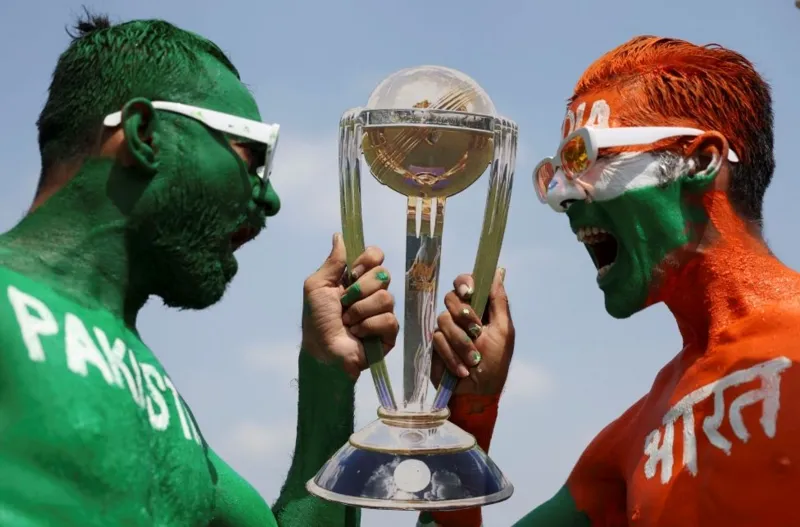Pope Francis dies latest: Details of Pope's final hours emerge - after pictures of Francis in open coffin released
The world is mourning Pope Francis, who died on Easter Monday aged 88 from a cerebral stroke and subsequent heart failure. Cardinals are meeting to plan the pontiff's funeral, which will be held on Saturday.
'He held our hands and hugged one of us': LGBTQ rights campaigner recalls meeting with Francis
Earlier, we looked at how Pope Francis's attitudes to the LGBTQ shifted and changed during his papacy, and how he softened the stance of the Catholic Church (see 12.43 post).
One story from Marianne Duddy-Burke, the executive director of DignityUSA, which advocates for LGBTQ rights within the Catholic Church, illustrates Francis's approach.
Duddy-Burke says his treatment of gay and lesbian people was a "seismic shift" for the better.
What a difference almost three decades makes
It was quite the change from 1986 - when the Vatican issued a controversial "Letter to the Bishops on the Pastoral Care of Homosexual Persons", in response to the world of DignityUSA.
It resulted in many of the organisation’s chapters being expelled from their home parishes and barred from meeting on Catholic properties, Duddy-Burke told our US partner network NBC News.
Nearly three decades later, the Vatican invited Duddy-Burke, and two other members of the Global Network of Rainbow Catholics, to meet with Francis in October 2023.
They talked to him about the importance of his statement earlier that year calling for the decriminalisation of homosexuality worldwide.
But they also stressed that the sentiment needed to be implemented by Catholic bishops and politicians.
What Francis told campaigners
"He was very warm, and he laughed with us, and he made eye contact through the whole thing," Duddy-Burke said. "He sat and held our hands and hugged one of us."
At the end of their meeting, Francis told them, in Italian: "Your work is important. Keep pressing on."
Duddy-Burke recalled the moment through tears.
She said there was a huge public response to photos and news about the meeting, which "showed just how significant it was for representatives [of the community] to be seen with the Pope."
Francis the reformer: 'Who am I to judge?' and his attitudes to the LGBTQ+ community
It's fair to say Pope Francis forged a reputation as a compassionate reformer throughout his career in the church.
He shook up the institution, without changing its core doctrines.
After Benedict's surprise resignation as pontiff and retirement, Francis was elected on a mandate to change the outdated Vatican bureaucracy and modernise its finances.
But he went much further, too.
We're taking a look at the issues he approached in a different way - just look out for Francis the reformer in the headline on our posts.
'Who am I to judge?'
This became one of the Pope's most famous quotes.
In 2013, he was asked about a purportedly gay priest.
In reply, he said: "If a person is gay and seeks God and has goodwill, who am I to judge him? Who am I to judge?"
The comment sent a message of welcome to the LGBTQ+ community.
Two years later, in 2015, during his visit to the United States, Pope Francis had only one personal meeting - with his former student Yayo Grassi, who is gay, and his partner.
In 2016, Francis called for an end to "unjust discrimination" against gay people, and even said later in the same year that they deserved an apology. However, he kept the Catholic Church's official opposition to gay marriage.
Several years later, though, in 2020, he called for civil unions for same-sex couples, in a major departure from Vatican doctrine.
'Being homosexual is not a crime'
In 2023, Francis told The Associated Press: "Being homosexual is not a crime."
At the same time, he called for an end to civil laws that criminalise it.
A year later, he approved church blessings for same-sex couples.
His record was not always reformist and progressive. In 2024, he used an offensive slur for gay men, sources said, leading to a Vatican apology.
But earlier this year, in January, the Vatican allowed Italian gay men to be priests if they remain celibate.
'The Lord loves us as we are'
Another comment from 2023 perhaps sums up the Pope's general approach.
Francis was responding to young people on a podcast, in which he listened and responded to audio messages from young people ahead of a Catholic youth festival in Portugal.
One of the young people was Giona, an Italian in their early 20s who said they were "torn by the dichotomy between [their Catholic] faith and transgender identity".
Francis replied that "the Lord always walks with us... Even if we are sinners, he draws near to help us".
"The Lord loves us as we are; this is God's crazy love."
The longest - and shortest - conclaves in Vatican history
The conclave, as we've been reporting, should begin from 5 May, after a nine-day period of mourning that begins on the day of the funeral.
That's the process to elect a new pope, with certain cardinals charged with choosing the next pontiff.
While they decide, there is no contact with the outside world allowed.
It's a tradition that dates back centuries - and hasn't always gone as smoothly as the Vatican would like.
Three years to elect a pope
Never was this more apparent than in the mid-13th century, when one conclave lasted nearly three years, or 33 months to be precise.
That began in 1268 and ended in 1271, when Gregory X was finally chosen.
But to hurry the conclave on, residents tore the roof off the building where the cardinals were deliberating and restricted their meals to bread and water.
In a bid to avoid a repeat, Gregory decreed in 1274 that cardinals would only get one meal a day if the conclave stretched beyond three days.
Bread, water and wine would have been on the menu if conclaves went past eight days.
While the meals served at the Vatican's hotel these days are by no means gourmet, the cardinals will not go hungry - no matter how long they take.
And the shortest?
Before 1274, there were times when a pontiff was elected on the same day of their predecessor's death.
But after that, the church decided to wait at least 10 days before the first vote. This was later extended to 15 days to give cardinals time to get to Rome.
The quickest conclave observing the 10-day rule appears to have been the 1503 election of Julius II.
He was chosen in just a few hours, according to Vatican historian Ambrogio Piazzoni.
The one word to be inscribed on pope's tomb
It's not surprising a pope who chose to live more simply than his predecessors would also choose a simpler final resting place.
Francis will not be buried in the crypt beneath St Peter's Basilica, unlike almost 100 popes before him.
In a break with tradition, he will be laid to rest outside the Vatican, in the Basilica of Santa Maria Maggiore.
The church is dedicated to the Virgin Mary, who Pope Francis was deeply devoted to.
He would regularly pray here before the icon of the Virgin Mary, the Salus Populi Romani.
His last visit was on the eve of Palm Sunday, just nine days before his death.
Only seven other popes have been buried at Santa Maria Maggiore.
While previous popes have been entombed in three coffins nestled inside each other, made of cypress, zinc and elm, Francis has asked to be buried in a single wooden coffin.
The tomb will have just one word inscribed on it: Franciscus.
Explained: How the next pope will be chosen
With the death of Pope Francis, the wheels are in motion to select a new pontiff.
We know now that process will begin from 5 May - after a nine-day period of mourning ends - and Vatican sources say we should know the next pope within a month.
Sky News understands the conclave - the meeting of cardinals charged with electing the successor - is expected to happen more quickly than that.
How the election works
The election is conducted in conditions of secrecy, and the cardinals are shut away in the Vatican until they reach an agreement.
Usually, the college has a limit of 120 on voting-age cardinals.
In 2007, Pope Benedict passed a decree stating that cardinals needed to reach a two-thirds majority.
The election process can take days and the cardinals are not allowed to have contact with the outside world during this period.
The voting takes place in the Sistine Chapel and after all the votes have been cast, the papers are mixed, counted and opened.
White or black smoke
The ballot papers are then burned, and if a decision has been reached, white smoke is visible from the chimney to onlookers outside the Vatican.
Around 15 minutes after the white smoke appears, the announcement about the next pope will be made.
But, if black smoke is visible from the chimney, it means a decision is yet to be reached - and the voting process will continue.
To get the black smoke, the papers are burned with a chemical.
Watch below - who could succeed Francis? A look at some of the contenders...
Ursula von der Leyen confirms funeral attendance - but Putin won't go
Some more updates to bring you now on expected attendees at the Pope's funeral on Saturday.
The latest to confirm they'll be there is Ursula von der Leyen, the president of the EU Commission.
She follows other world leaders in announcing her plans to travel to Rome - see our 9.50 post for a look at who else will be there.
In what will come as no surprise, Russian President Vladimir Putin has confirmed he will not attend the funeral - though he did pay tribute.
The Pope's final thank you to his nurse and his 'calm' last afternoon
Vatican sources have given our team there a little insight into the Pope's final day.
On Easter Sunday, Francis made his final public appearance, turning up in the popemobile at St Peter's Square, where he greeted crowds on one of the most important days of the Christian calendar.
The 88-year-old pontiff appeared frail as he was wheeled out on to the balcony over the entrance of St Peter's Basilica, before being driven through the crowds of faithful gathered in the square.
He was met with cheers, applause and chants of "Viva il Papa" - meaning long live the pope.
According to sources at the Vatican, the Pope's personal nurse Massimiliano Strappetti asked him before his appearance if he thought he could manage it.
The pontiff insisted on going through with it.
Afterwards, the pope thanked him and said: "Thank you for taking me back to the square."
He then had a "calm" afternoon and enjoyed his dinner.
He died in the early hours of the following morning.
-SKY NEWS







